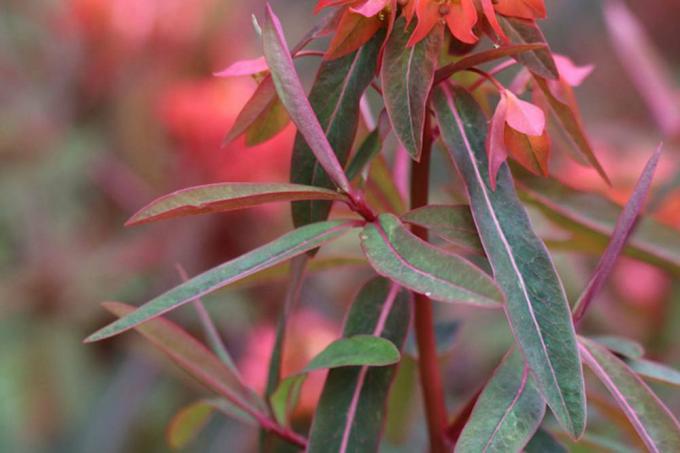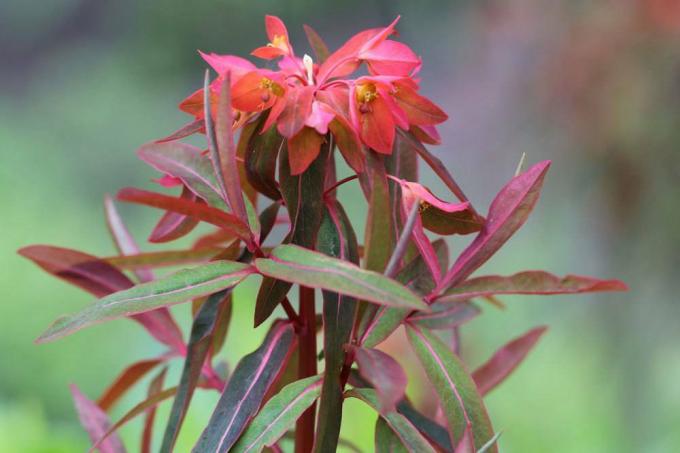
table of contents
- Location
- care
- Substrate
- plants
- to water
- Fertilize
- Cut
- Overwinter
- Multiply
- Diseases
Profile and care information open +conclude -
- Flower color
- Orange red
- Location
- Partial shade, sunny
- Heyday
- May June
- Growth habit
- upright, bushy, perennial
- height
- up to 80 centimeters high
- Soil type
- loamy, gritty, clayey
- Soil moisture
- moderately moist, fresh
- PH value
- neutral, slightly acidic
- Limescale tolerance
- Calcium tolerant
- humus
- rich in humus
- Poisonous
- Yes
- Plant families
- Spurge Family, Euphorbiaceae
- Plant species
- Rock garden plants, Perennials, Potted plants
- Garden style
- Rock garden, ornamental garden, pot garden
The orange-red flowers of Euphorbia griffithii 'Fireglow' shine strikingly and powerfully. The milkweed plant can score with its beauty not only in spring, but also impresses with its beautifully colored leaves in autumn. The perennial shrub is particularly effective in group planting and can be used here in many ways. In terms of care and location, the herbaceous perennial does not make any exotic demands on the passionate hobby gardener.
Location
Spurge is an interesting plant that adds color to the garden and can be left to its own devices most of the time. When choosing a location, it is important to plant the perennial out of the reach of young children. The viscous milky sap of the plants, which leaks out of the plant from even the smallest injuries and serves as a wound closure and protection against eating, is poisonous.
Its strong irritant effect can cause burns on the mucous membrane and itchy eczema on the skin. It also makes sense for the adult gardener to wear gloves when caring for the plant. Euphorbia griffithii 'Fireglow' originally comes from the regions of the Himalayas. Cold can do little to the milkweed plant, but the perennial has no objection to a sheltered place.

- The location should be bright
- light penumbra is tolerated
- suitable for planting hillsides and ornamental beds
- ideal plant for the rock garden
care
From May until well into June, the perennial shows itself in its full bloom. The bright red colored bracts of the plant are an eye-catcher in the garden. Fireglow enhances dreary edge areas and, with its 80 cm height, serves as a distinctive background planting. The perennial can be optimally combined with small plants, such as Catnip, Ornamental sage and lavender. The bare trunk area of tall trees disappears under the decorative, dark green foliage of the milkweed.
In order to promote the color development of leaves and flowers, a few hours of sunshine should fall daily for the Asian plant. However, too much sunlight can also cause the milkweed to fade. In this case it makes sense to relocate Euphorbia griffithii to a more suitable location.
Substrate
The perennial known colloquially as "Griffith's milkweed" prefers a soil rich in humus. In order to protect the roots from drying out quickly, the soil should meet a few basic requirements.
- relaxed and profound
- loamy to loamy clayey
A calcareous substrate does not have a negative effect on the development and resilience of the perennials. If you want to save yourself regular mulching in order to counteract compaction of the soil, you should use expanded clay. This material prevents the soil from sticking together due to drought and pressure from the roots.

At the same time, the small spheres serve as a water reservoir and slowly release the valuable moisture into their surroundings. Instead of expanded clay, small pebbles have proven their worth. These are mixed with the excavated substrate immediately when planting. Euphorbia griffithii is suitable for the permanent planting of pots. Conventional potting soil mixed with small amounts of clay is suitable as a substrate.
plants
Planting of Euphorbia griffithii
The plant with the distinctive leaves is an ornament in home gardens. The site and soil conditions can easily be met. A few steps are necessary to transfer purchased plants from the trade into the ornamental bed.
- free the perennial from the purchase vessel
- Generously remove old substrate
- Allow the root network a sufficient bath in lukewarm water
- Cut dead plant parts
The dug planting hole should be twice as large and deep as the circumference of the roots. This has the advantage that the perennial has enough space to unfold in the loose substrate. The loosening of the surrounding soil has also proven itself and effectively contributes to the development of the freshly planted plants.
- the excavated substrate should be mixed with clay and humus
- Spread compost in the planting hole
- the perennial should only be inserted up to the upper root neck
- Fill the cavities with the prepared soil and press down
The soil must not dry out for the first 14 days. The beauty of the milkweed family comes into its own in a group of 6 to 8 plants. A minimum distance of about 25 - 35 cm should be kept between the individual perennials. Less is possible, but there is a risk that the lower plant regions will not receive enough sunlight and the bloom formation in this area will suffer. At the same time, the susceptibility to infestation by pests and diseases increases.
Cultivation in potted plants
Euphorbia griffithii are suitable as potted plants. In sufficiently large containers, they bring color to the balcony or the bright terrace. The effort and maintenance requirements are slightly higher here than with Euphorbia in the garden.
- Place a drainage layer made of porous, inorganic material on the bottom of the bucket
- an approx. 5 cm thick substrate layer
- the vessel should be stable
- a climbing aid is not necessary
The substrate of potted plants dries out quickly and has to be fertilized regularly during the main growing season. Repotting takes place as soon as the plant completely fills the container. If necessary, you can use this opportunity to rejuvenate the perennials by dividing them.

to water
The perennial from Bhutan is frost-tolerant, but cannot cope with drought and waterlogging. For this reason, it makes sense to find the right level of water supply. Drainage is an important measure to prevent damage and disease in milkweed. In the bed, this takes place via a loose soil, with potted plants a layer of lava split or Pottery shards this task.
- Water regularly from March to September
- Avoid waterlogging
- Let the top substrate layer dry completely
Older perennials are able to absorb water from the deeper layers of the earth with their extensive network of roots. Young and freshly planted plants lack this ability. Therefore, on warm days, it makes sense to check the moisture content of the soil several times a day. The water is poured in the early morning and late afternoon.
This prevents the water from evaporating too quickly in the midday heat. This danger exists especially with Euphorbia griffithii in the planter. The substrate in the tub can only store a limited amount of moisture. It makes sense to pay extra attention to these perennials.
Bark mulch, brushwood, and shading the soil can help the soil retain water longer. In the cold season should not be poured. In the case of potted plants, it is advisable to regularly remove excess irrigation and rainwater from the pots and saucers.
Fertilize
Supply of nutrients
When it comes to fertilizing, a distinction should be made between milkweed in the garden and in planters. In the bed, organic and mineral substances are equally suitable to supply the plants with the necessary minerals. Long-term or liquid fertilizers should be used for potted plants. Euphorbia griffithii needs few nutrients, so the amount stated on the package insert can be reduced.
- Compost, horn shavings, and coffee grounds are all good for Garden plants
- the organic fertilizer is applied in spring and late summer
- In winter you should refrain from administering nutrients

Pale foliage and low flowering may be due to a fertilizer problem. In this case, it is important to find the cause quickly. If the milkweed has been over-fertilized, the substrate should be generously changed and left for approx. No fertilizer of any kind is required for 6 weeks. Deficiency symptoms are also noticeable on the leaves. Under no circumstances should you add too much fertilizer at once, but increase the dose slowly.
Cut
Cutting the milkweed
The pruning of the Euphorbia takes place in early spring, even before the perennial begins to shoot. The withered, aerial shoots increase the winter hardiness of the plant.
- Cut off dead stems close to the ground
- Dead and wilted plant parts can also be cut during the growing season
Sharp scissors and sturdy gloves are essential for this work step. The milky sap of Euphorbia griffithii irritates the skin and is poisonous.
Overwinter
The perennials from the Himalayas are hardy and can easily withstand temperatures of up to - 25 ° C. However, the milkweed plants have no objection to a warming layer of bark mulch or brushwood.
In the case of potted plants, the entire container is wrapped with fleece, the upper shoots remain free. House walls and walls can protect the pot from frost and icy winds. It is not necessary to move to a cold-proof room. From April or as soon as there is no longer any threat of severe frost, the protection can be removed.
Multiply
Euphorbia griffithii likes to actively contribute to its reproduction itself, provided the perennial shrub feels comfortable in its location. With optimal care conditions, it is not uncommon to have to put a stop to the growth of the milkweed family. With a border or Rhizome barrier you can get the reproductive urge of the plants to some extent under control.
The ideal time to cut off the young offshoots is spring. From April around, the perennials have developed enough so that the stress of moving them is hardly any longer a burden.
- Use a spade or a digging fork to cut out the offshoots generously
- at the new location
- pour vigorously
Further preparations and measures do not have to be taken. Root division is not recommended. The older the plants get, the more abundant growth and flowering will be. It is not uncommon for the offshoots to take some time before the first buds appear.

Diseases
Diseases and Pests fight
The milkweed Euphorbia griffithii 'Fireglow' is of no interest to snails. The viscous sap frightens the slimy garden dwellers. Other pests and pathogens are less picky.
Known diseases include:
- Stem rot (Phytophtora sp.)
- Gray mold (botrytis cinerea)
- Spider mites
- Whitefly
- Root rot
With the right care, the infestation of many can be damaged insects and avoid fungal pathogens. Stressed and weakened perennials are more susceptible than healthy relatives.
The most important basic rules for cultivating milkweed include:
- water regularly
- Avoid waterlogging and drought
- Maintain a minimum distance to other milkweed plants
- do not pour over the leaves
- avoid dark locations
- Mulch soil and weed remove

